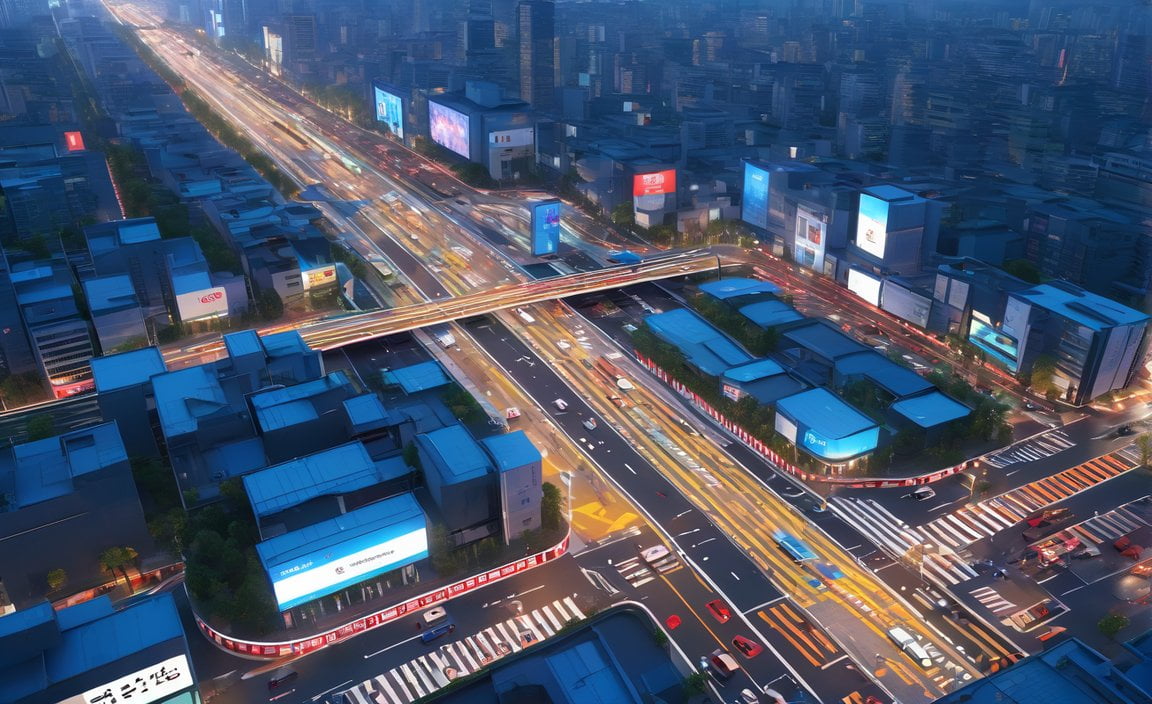Advantages of Advanced Traffic Control Systems
Implementing advanced traffic control systems brings numerous benefits to our roads and highways. These sophisticated systems, carefully designed and managed by seasoned transportation engineers, have the power to revolutionize traffic flow and enhance overall transportation efficiency. By leveraging their expertise in civil engineering and transportation planning, these professionals can optimize traffic patterns, reduce congestion, and improve road safety. Through the integration of innovative technologies and the careful analysis of complex data, advanced traffic control systems are paving the way for a smoother, safer, and more sustainable future of transportation.
Key Takeaways:

Traffic control systems ensure the safety of drivers, passengers, and pedestrians by coordinating the flow of vehicles and pedestrians and minimizing the risk of accidents.
These systems help organize traffic movement and maintain order on the roads through the use of traffic signals, signs, and markings.
Implementing traffic control systems reduces the severity of accidents by preventing high-intensity collisions and allowing for safe crossing at road intersections.
Traffic control systems are crucial for eliminating traffic congestion and gridlock by managing traffic flow and optimizing signal timings.
Efficient traffic control systems contribute to improved fuel efficiency by reducing congestion, minimizing idling time, and reducing emissions and energy waste.
Overall, traffic control systems provide numerous benefits including enhanced safety, organized traffic movement, reduced accidents, elimination of gridlock, and improved fuel efficiency.
Advantages of Traffic Control Systems
Traffic control systems are essential for ensuring safety, order, and efficiency on the roads. Let’s explore the key advantages of implementing these systems:
Ensures Safety of Drivers, Passengers, and Pedestrians
The primary objective of traffic control systems is to prioritize safety for everyone on the road. By coordinating the flow of vehicles and pedestrians, these systems help prevent accidents and minimize the risk to all road users. With clear instructions and organized movements, traffic control systems create a safer environment for everyone[^1].
Organizes Traffic Movement and Order
Traffic control systems play a vital role in organizing the movement of vehicles and maintaining order on the roads. Through the use of traffic signals, signs, and markings, these systems provide clear directions and instructions to drivers. By ensuring that everyone follows the rules of the road, traffic control systems enable a smoother flow of traffic and reduce the chances of collisions and congestion[^1][^3].
Reduces Severity of Accidents
Implementing traffic control systems can significantly reduce the severity of accidents. These systems help in preventing high-intensity accidents, such as right-angle collisions, by providing designated areas for turning vehicles. Moreover, traffic control systems allow for the interception of heavy traffic, enabling safe crossings at road intersections. By minimizing the risk of accidents, these systems contribute to overall road safety[^2][^4].
Eliminates Traffic Gridlock
One of the most significant advantages of traffic control systems is their ability to eliminate traffic congestion and gridlock. By managing traffic flow and optimizing signal timings, these systems effectively reduce delays and improve the overall efficiency of transportation networks. As a result, drivers experience less frustration and wasted time, while transportation networks operate more smoothly[^2].
Improves Fuel Efficiency
Efficient traffic control systems contribute to improved fuel efficiency. By reducing congestion and ensuring smoother traffic flow, vehicles spend less time idling and consume less fuel. This not only reduces emissions and energy waste but also leads to significant cost savings for drivers and transportation agencies. Implementing traffic control systems is therefore an environmentally-friendly and economically beneficial solution[^2].
In conclusion, traffic control systems provide numerous advantages, including enhanced safety, organized movement of traffic, reduced accidents, elimination of gridlock, and improved fuel efficiency. These systems play a critical role in maintaining order and maximizing the capacity of road networks[^1][^2].
Sources:
1. Polytechnic Hub: Advantages and disadvantages of traffic control signals on road
2. Diablo Controls: Six Reasons Why Traffic Control Systems Are Important
If you want to know the advantages of roadways over railways, click here to explore more!
Discover the remarkable advantages of sea transport by clicking here and dive into a world of limitless opportunities.
Unveil the incredible advantages of a smart traffic management system by clicking here and witness the future of urban transportation.
Experience the unparalleled advantages of solar buses that are revolutionizing public transportation. Click here to learn more!
Uncover the exceptional advantages of storing water underground and develop sustainable solutions. Click here to delve into an intriguing world of water management.
Optimized Use of Transportation Infrastructure

The optimized use of transportation infrastructure is crucial for efficient traffic management and improving the overall transportation experience. Advanced traffic control systems play a vital role in achieving this optimization by enhancing traffic flow, reducing congestion, and maximizing the capacity of road networks. In this article, we will explore the key advantages of implementing advanced traffic control systems and how they contribute to the optimized use of transportation infrastructure.
Increased Traffic Flow and Reduced Congestion
One of the significant advantages of advanced traffic control systems is their ability to optimize traffic flow and minimize congestion. By leveraging real-time data and intelligent algorithms, these systems can dynamically adjust traffic signals and coordinate the movement of vehicles. This ensures smoother traffic flow, reduces delays, and minimizes congestion hotspots. As a result, commuters can enjoy shorter and more efficient journey times, leading to enhanced productivity and overall satisfaction.
Improved Road Safety
Implementing advanced traffic control systems also prioritizes road safety by coordinating the flow of vehicles and providing clear directions to drivers. With features like smart traffic lights and real-time traffic monitoring, these systems can promptly respond to changing traffic conditions and adjust signal timings accordingly. By minimizing conflicts and enhancing the predictability of traffic movements, advanced traffic control systems significantly reduce the risk of accidents, creating a safer environment for both drivers and pedestrians.
Enhanced Transportation Efficiency
Efficient traffic control systems contribute to the optimized use of transportation infrastructure by maximizing its capacity and reducing wastage. By managing traffic flow and optimizing signal timings, these systems help eliminate gridlock and reduce fuel consumption. With reduced congestion and minimized idle times at intersections, vehicles can move more smoothly, leading to improved fuel efficiency. This not only benefits individual commuters but also has a positive impact on the environment by reducing carbon emissions.
Integration of Innovative Technologies
Advanced traffic control systems embrace innovative technologies like Internet of Things (IoT) and real-time data analysis. By integrating connected devices and sensors into the existing infrastructure, these systems can collect and analyze real-time traffic data. This data is then used to make informed decisions and optimize traffic control strategies. By leveraging the power of IoT technology, advanced traffic control systems can adapt to changing traffic conditions, anticipate future trends, and continuously improve transportation efficiency.
Key Takeaways:
- Implementing advanced traffic control systems leads to increased traffic flow and reduced congestion, resulting in shorter and more efficient commute times.
- These systems prioritize road safety by coordinating traffic movements, minimizing conflicts, and providing clear directions to drivers.
- Advanced traffic control systems contribute to enhanced transportation efficiency by maximizing infrastructure capacity, reducing fuel consumption, and eliminating gridlock.
- Integration of innovative technologies like IoT enables real-time data collection and analysis, leading to informed decision-making and continuous improvement in traffic control strategies.
References:
1. Smart Traffic Control Using IoT – Rishabh Soft
2. A Flexible Traffic Signal Coordinated Control Approach and System – S. Aditya et al.
Efficient management of traffic signals and timings
Efficient traffic management systems play a crucial role in optimizing traffic flow and improving overall mobility. By implementing advanced traffic control systems, traffic engineers can effectively manage traffic signals and timings, leading to numerous advantages. In this article, we will explore the benefits of efficient management of traffic signals and timings, highlighting the positive impact it has on traffic flow, congestion reduction, and overall transportation efficiency.
Optimizing Traffic Flow with Real-time Data
Efficient traffic management systems utilize real-time traffic data to make informed decisions and adjust signal timings accordingly. By integrating data from various sources such as vehicles, traffic lights, and sensors, traffic managers can react to changing traffic conditions promptly. This allows them to optimize signal timings based on actual traffic flow, minimizing delays and improving overall traffic efficiency.
Minimizing Congestion and Delays
One of the significant advantages of efficient traffic control systems is their ability to minimize traffic congestion and delays. By synchronizing traffic signals along a road corridor or network, traffic managers create a smooth flow of traffic. Vehicles can travel at a continuous speed without unnecessary stops at red lights, reducing travel times and increasing efficiency. This synchronization of traffic signals helps to minimize congestion, leading to smoother traffic flow and improved overall transportation experience.
Enhancing Road Safety
Efficient management of traffic signals and timings prioritizes road safety. By implementing intelligent traffic control algorithms, traffic engineers can minimize the risk of accidents, including right-angle collisions. Coordinated traffic signals provide clear directions and instructions to drivers, reducing confusion and potential conflicts. This organized movement of traffic greatly enhances road safety, making the roads safer for all users—both pedestrians and drivers.
Improving Fuel Efficiency
Implementing efficient traffic control systems contributes to improved fuel efficiency. By reducing congestion and minimizing idling time, these systems help drivers save fuel consumption. With optimized signal timings, vehicles can maintain a consistent speed, reducing the need for acceleration and deceleration. Consequently, the efficient management of traffic signals and timings leads to fuel savings, benefiting both the environment and drivers’ wallets.
Key Takeaways:
- Efficient management of traffic signals and timings optimizes traffic flow and improves overall mobility.
- Real-time data integration allows traffic managers to make informed decisions and adjust signal timings accordingly.
- Synchronized traffic signals minimize congestion, reduce delays, and increase overall transportation efficiency.
- Efficient traffic control systems prioritize road safety by minimizing the risk of accidents and providing clear instructions to drivers.
- Implementing advanced traffic control systems improves fuel efficiency by reducing congestion and minimizing idling time.
Sources:
- The Benefits of Efficient Traffic Management Systems
- Efficient Traffic Management System
Integration of Innovative Technologies for Smarter Traffic Control
Smart traffic control systems are revolutionizing urban mobility through the integration of innovative technologies. These advanced systems leverage data-driven approaches and cutting-edge technologies to optimize traffic flow, enhance safety, and reduce environmental impact.
Key Takeaways:
- Smart traffic control systems utilize real-time data from sensors, cameras, and smart devices to make informed decisions and guide traffic movements.
- These systems can reduce the environmental impact by optimizing traffic flow, minimizing congestion, and reducing fuel consumption and emissions.
- Implementing smart traffic control systems may present challenges such as integrating and synchronizing various traffic data sources and updating existing infrastructure to support these systems.
- Smart traffic control systems significantly improve safety on the roads through real-time data analysis and intelligent algorithms.
- By coordinating with emergency vehicles and optimizing traffic flow, these systems minimize accidents and enhance overall safety for motorists and pedestrians.
Smart traffic control systems offer numerous benefits for urban transportation. By integrating innovative technologies, these systems optimize traffic flow, improve safety, and reduce environmental impact. However, their implementation may face challenges such as data integration, infrastructure updates, and budget constraints. Nonetheless, these systems provide promising solutions for revolutionizing urban mobility.
Citations:
– Isarsoft: Smart Traffic Control Systems
– Hindawi: Intelligent Traffic Management System Based on the Internet
FAQ
Q1: What is a traffic control system?
A1: A traffic control system is a system that manages and controls the flow of traffic on roads. It includes various components such as traffic signals, signs, and markings that provide instructions to drivers and pedestrians.
Q2: What are the advantages of implementing traffic control systems?
A2: Implementing traffic control systems provides several advantages. It ensures the safety of drivers, passengers, and pedestrians by coordinating the flow of vehicles and minimizing the risk of accidents. It also organizes traffic movement and maintains order on the roads, reducing the severity of accidents and eliminating traffic gridlock. Additionally, traffic control systems contribute to improved fuel efficiency and reduced emissions.
Q3: How do traffic control systems improve safety?
A3: Traffic control systems improve safety by coordinating the flow of vehicles and pedestrians, preventing accidents and minimizing the risk to all road users. They also help in reducing the severity of accidents, such as right-angle collisions, and enable safe crossing at road intersections.
Q4: How do traffic control systems reduce congestion?
A4: Traffic control systems help in reducing congestion by managing traffic flow and optimizing signal timings. By doing so, they can minimize delays, improve the overall efficiency of transportation networks, and eliminate traffic gridlock.
Q5: How do traffic control systems improve fuel efficiency?
A5: Traffic control systems contribute to improved fuel efficiency by reducing congestion and ensuring smoother traffic flow. When vehicles spend less time idling in traffic, they consume less fuel, leading to reduced emissions and energy waste.












